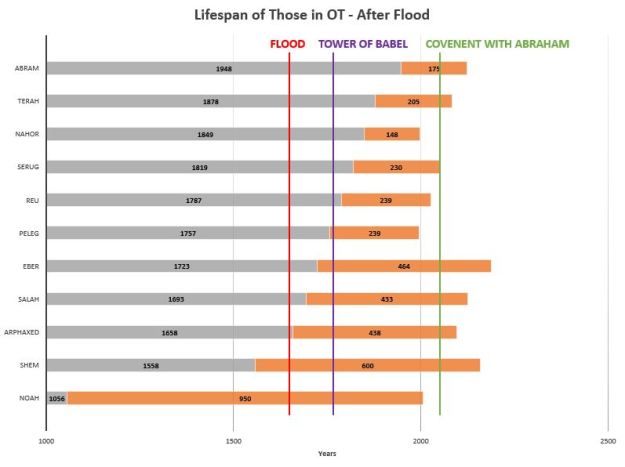Genealogies are not an easy thing to read in the Bible. You tend to read a lot of names you’ve never heard of or know anything about. Because of that, many of us tend to simply skim through those passages in Scripture, if not just skip them altogether. Let me caution you from doing that. It’s amazing the things you can learn from those genealogies.
A few days ago, I posted the first part of this article. If you haven’t read it yet, please do that before continuing on (Who Lived With Whom – Part 1). I’ll wait. No…seriously. Go read it. We won’t start without you.
…
…
…
OK, good. So, we saw from the genealogy in Genesis 5 that many generations lived on the earth at the same time. It’s possible that everyone on the ark received a second-hand account of Creation because Noah’s father Lamech could have sat and talked face-to-face with Adam. However, now we need to take a look at the genealogies listed in Genesis 11. This genealogy goes from Noah and the flood all the way to Abraham. Using the same method as described in the other post, here’s what you get when you throw all those dates and ages into Excel.

As with the other graph, the sections in orange represent each man’s time on earth while the gray represents the time since Creation before the man was born. The far left of this chart represents the year 1,000. Note the red line on the graph represents when the flood occurred (Noah was 600 years old at the time according to Genesis 7:6).
There are two more lines on the graph that I added for reference that represent the Tower of Babel and the time when God made His covenant with Abraham. Please understand that while the dates of the red and green lines representing the flood and the covenant are known with 100% certainty from Scripture, the exact date of the Tower of Babel is somewhat unknown. Genesis 10:25 tells us, “To Eber were born two sons: the name of one was Peleg, for in his days the earth was divided; and his brother’s name was Joktan.” The earth being divided is a reference to how all the people were scattered at the Tower of Babel. Therefore, we know that event happened during the 239 year life of Peleg, but how can we narrow it down more than that? Honestly, I can’t. I’m not that smart, and the Bible doesn’t give a more exact date. However, I didn’t just randomly put the purple line on the graph. The date I used came from the Archbishop James Ussher and his writing Annals of the Old Testament, deduced from the first origins of the world in 1650.
Now, study over that graph for a minute and see what you notice. Here’s some of the things that jump out to me and the questions I’m left with.
- Have you ever seen a movie where someone goes and seeks the advice of someone that is significantly older? That’s because they would have much more knowledge and wisdom due to their age. Look at Noah. Other than possibly his wife, he was significantly older than anyone else on the earth. Not just a couple decades, and not just the people in his town. We are talking on the order of 500-600 years older than anyone on the planet! Keep in mind that he was 600 years old when the flood happened (Gen 7:6).
- Shem outlived Abraham. You read that right. Abraham died 35 years before Shem did! Imagine the things that Shem knew and witnessed. He lived for nearly 100 years on the pre-flood earth, and then lived another 500 years after the flood. He knew very well what type of drastic changes the flood caused to the earth. He also lived through the Tower of Babel and the destruction of Sodom and Gomorrah.
- Although they aren’t on the graph (because it was already cluttered enough), Isaac was born when Abraham was 100 years old (Gen 21:5). Jacob and Esau were born when Isaac was 60 years old (Gen 25:26). That means the twin boys were 15 years old when Abraham died (Gen 25:7). Keep in mind, though, that Shem was still alive. Jacob and Esau would have been 50 years old when Shem died. Gen 26:34 says that Esau took two wives when he was 40 years old, so could Shem have been at the wedding? That also means, Jacob (later known as Israel) could have had a face-to-face conversation with someone who lived prior to the flood, and then passed on that knowledge to his twelve sons and all the Children of Israel.
- Notice there are two very significant changes in man’s life expectancy. Prior to the flood and including Noah, men lived well into their 900’s. Starting with Shem and for the next few generations, that age was nearly cut in half. Then, starting with Peleg, that age was almost cut in half again. These were not gradual changes in the lifespans. These were drastic, sudden changes. That leads me to believe that something happened to cause this. Most believe that the climate of the earth changed drastically after the flood (I personally agree with this). The change in climate and the earth could explain the first major change. However, what caused it to drop from the mid-400’s to the 200’s starting with Peleg? The Towel of Babel occurred during Peleg’s life and people were scattered all over the earth. Could that cultural change have caused another sudden drop in life expectancy? If so, why?
Did you notice anything in these charts that I didn’t mention? If so, please comment and let everyone else know.
I hope that these two posts have helped you to recognize some things that maybe you’ve never seen before. Doing this has definitely changed the way I look at and read Genesis. I no longer see each man’s life as being its own independent story. Instead, it is all one long story of God interacting with his people.
